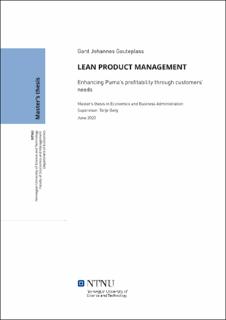| dc.contributor.advisor | Berg, Terje | |
| dc.contributor.author | Gauteplass, Gard Johannes | |
| dc.date.accessioned | 2021-09-14T17:17:27Z | |
| dc.date.available | 2021-09-14T17:17:27Z | |
| dc.date.issued | 2020 | |
| dc.identifier | no.ntnu:inspera:55685018:60885956 | |
| dc.identifier.uri | https://hdl.handle.net/11250/2777217 | |
| dc.description.abstract | Ideen om Lean thinking har røtter helt tilbake til begynnelsen av 1900, der Henry Ford begynte
å standardisere deler og samlebåndsproduksjonen. Siden den gang har Lean blitt videreutviklet
i produksjonsselskaper som Toyota for å korte ned produksjonstiden, bedre kvalitet, senke
kostnadene og forbedre selskapets lønnsomhet. Denne studien fokuserer på lønnsomheten til
Lean thinking i produktstyring som en casestudie i Puma SE. "Lønnsomhet" er definert i
Google-ordboken som "I hvilken grad en virksomhet eller aktivitet gir overskudd eller
økonomisk gevinst". Denne avhandlingen søker derfor å undersøke sammenhengen mellom
Lean thinking og produktstyring, og hvordan en implementering vil påvirke selskapets
lønnsomhet. For dette formålet ble det samlet inn data gjennom en spørreundersøkelse, samt
intervjuer med ledere fra forskjellige avdelinger innen Puma. Resultatene viser generelt at det
er noen store utfordringer i selskapets produktstyring, Lean-brukere vises på individuelt nivå,
noe som indikerer at Lean thinking foreløpig ikke har blitt implementert og prioritert i Pumas
styringspraksis. Videre er det en stor variasjon i hvordan de forskjellige Lean-verktøyene og
metodene tolkes, forstås og brukes i Puma sine forskjellige regioner og forretningsenheter.
Totalt sett indikerer resultatene at Puma kan øke lønnsomheten ved å bruke Lean-praksis på
utfordringene som de står overfor i produktstyring. Basert på brukervennlighet er de mest
egnede Lean-verktøyene for Pumas produktstyring: Value Stream Mapping, Kanban og KPIs. | |
| dc.description.abstract | The idea about Lean thinking has roots all the way back to early 1900, where Henry Ford began
to standardizing parts and the assembly line production. Since then, Lean has been further
developed in manufacturing companies as Toyota to shorten the lead time, better quality, lower
the cost and enhance the company’s profitability. This study focuses on the profitability of
Lean thinking in product management as a case study in Puma SE. “Profitability” is defined in
the Google dictionary as “The degree to which a business or activity yields profit or financial
gain”. This thesis therefore seeks to examine the connection between Lean thinking and
product management, and how an implementation will affect the company’s profitability. For
this purpose, it was collected data through a survey, as well as interviews with managers from
different departments within Puma. The results generally show that there are some major
challenges in the company’s product management, Lean users appear on individual level,
which indicates that Lean thinking is currently not implemented and prioritized in Puma’s
management practice. Moreover, there is a big variation in how the different Lean tools and
methods are interpreted, understood and utilized in their different regions and Business Units.
Overall, the results indicate that Puma can increase its profitability by applying Lean practices
to the challenges that the product management face. Based on usability, the most suitable Lean
practices for Puma’s product management are: Value Stream Mapping, Kanban and KPIs. | |
| dc.language | | |
| dc.publisher | NTNU | |
| dc.title | LEAN PRODUCT MANAGEMENT - Enhancing Puma’s profitability through customers’ needs | |
| dc.type | Master thesis | |
